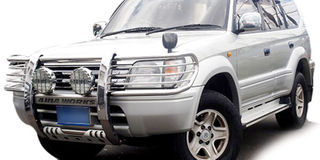Ask the Mechanic

SHOULD I REPLACE MY BRAKE SYSTEM PARTS?
Hello Paul, recently, my Toyota Prado brake master cylinder and brake calipers were found leaking and jamming because of rust damage and leaking seals. What can I do to resolve this and how can I avoid this situation in future?
Allan Kiiza
Hello Allan, sorry about your predicament. You may need to replace the corrosion damaged or leaking brake master cylinder and brake calipers. I suggest you also inspect the brake fluid lines in case they have also been affected by the corrosion damage. Since the condition of a brake system is an important safety concern, you need to pull all the stops.
The master cylinder and calipers help to build hydraulic pressure in the brake system, which in turn determines the braking distance or how fast you are able to stop the vehicle during emergency braking. In a worst case scenario, a severe leak in the brake fluid system can cause complete and catastrophic failure of the brakes.
Jamming brake calipers can also cause an accident due to sudden unexpected failure to disengage the brakes while speeding on the highway. Going forward, you can prevent this by inspecting and servicing the brake system and brake fluid during recommended periodic maintenance. Brake fluid should be replaced every two to three years or 30,000 to 40,000 kilometres, depending on the car and brake fluid manufacturer recommendations.
Brake fluid is designed to inhibit or prevent corrosion build up, cool the brake system to protect seals and metallic components as well as build hydraulic pressure for good performance.
Over time, brake fluid becomes dirty as it carries away soot from the different metallic components.
Brake fluid is also hygroscopic and tends to absorb moisture. This affects its ability to protect the brake system from corrosion damage. Matter of fact, the aged brake fluid now helps to accelerate corrosion damage of costly brake system components. Ageing brake fluid tends to have a lower boiling point than it is designed to have. This reduces its ability to act as a heat transfer agent, which is designed to cool the brake system.

MY TOYOTA NOAH STOPS WHILE TURNING
Hello Paul, I own a Toyota Noah which stops suddenly when trying to negotiate a corner. What could be the cause?
Tukei
Hello Tukei, you may have a leakage of unmetred air from the air intake pipe between the air mass sensor after the air cleaner and the engine throttle. Unmetred air intake will distort the fuel air ratio as regulated by the engine management system.
This will cause erratic running or engine stalling (stopping suddenly) when you load it during steering or switching on other accessories such as air conditioning. Another reason for engine stalling when you load it can be due to loss of power caused by a dirty air cleaner element, worn-out spark plugs or a clogged dirty fuel filter.
Rarely does a dirty throttle assembly impede free movement of the throttle valve and air intake, causing a drop of engine power which leads to stalling.

HOW MUCH TYRE PRESSURE DO I NEED FOR MY MOTORCYCLE?
Hello Paul, I am a medical work and I ride a motorcycle (TVS HLX 125) to and from hospital. What tyre pressure is good for keeping my size 17 tyres in good shape for safety while riding? The user manual recommends 25psi (front) and 28 psi (rear tyre). However, due to our poor road conditions, I feel the recommended tyre pressure is too low.
Quraish
Hello Quraish, motorcycles usually have bigger size tyres with different aspect ratios at the rear because they are rear driven and it helps with stability and rideability when the rear tyre has better traction and road grip. Therefore, the tyre pressure should not be the same. Similarly, it is recommended that you ride on the manufacturer recommended tyre pressures for your own safety, ride comfort and tyre life span.
The TVS motorcycle online catalogue for the HLX 125 motorcycle declares the front tyre size as 2.75 x 17 and the rear tyre size as 90/90 x 17. The recommended tyre pressure for the front tyre is 1.75 kg/cm (25 psi). The recommended tyre pressure for the rear tyre with one passenger is 2.25 kg/cm (32 psi). With two passengers the recommended rear tyre passenger is 2.53kg/cm (36psi).
The manufacturer recommended tyre pressures are important because they are a result of rigorous testing. Incorrect tyre pressure will affect your tyres’ road grip and general performance as you ride. Over inflated tyres may compromise your safety as the tyres are susceptible to bursting, which may endanger you or your passenger.
Your tyres’ lifespan will be reduced with under inflation or over inflation as the tyre walls tend to get damaged or suffer uneven wear. Only alter the rear tyre pressure when you are riding solo or carrying a passenger in accordance to manufacturer’s guidelines.

WHY IS MY CAR NOT PUMPING FUEL?
My Mercedes Benz 230E does not pump fuel properly. Even if there is enough fuel, it behaves as though the tank is empty. What could be the problem?
Anonymous
Hello Anonymous, it is always useful to start with the basics. Have you replaced your fuel filter since your car’s fuel system started failing? If you have not, it may have damaged your fuel pump. However, before you replace the fuel pump, make sure the fuel lines from the pump are not damaged or leaking fuel pressure. Lastly, a computer will help confirm that an engine management sensor such as the crank angle sensor is not faulty.
The crank angle sensor keeps the engine control module updated with the running status and speed of the engine. When this sensor fails, the engine control module will withhold fuel supply on the assumption that the engine is not running. This can create a false impression that the fuel pump is faulty.
Send sms: mycar (space) your comments and questions to 6933 or email themx to: [email protected]




